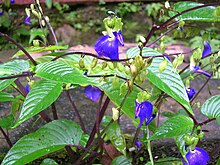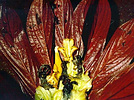You are here
Magnoliopsida
Gesneriaceae Rich. & Juss.
EOL Text
Gesneriaceae is a family of flowering plants consisting of ca. 150 genera and ca. 3,200 species in the Old World and New World tropics and subtropics, with a very small number extending to temperate areas. Many species have colorful and showy flowers and are cultivated as ornamental plants.
Most species are perennial herbs or subshrubs but a few are woody shrubs or small trees. The phyllotaxy is usually opposite and decussate, but leaves have a spiral or alternate arrangement in some groups. As with other members of the Lamiales the flowers have a (usually) zygomorphic corolla whose petals are fused into a tube and there is no one character that separates a gesneriad from any other member of Lamiales. Gesneriads differ from related families of the Lamiales in having an unusual inflorescence structure, the "pair-flowered cyme", but some gesneriads lack this characteristic, and some other Lamiales (Calceolariaceae and some Scrophulariaceae) share it. The ovary can be superior, half-inferior or fully inferior, and the fruit a dry or fleshy capsule or a berry. The seeds are always small and numerous. Gesneriaceae have traditionally been separated from Scrophulariaceae by having a unilocular rather than bilocular ovary, with parietal rather than axile placentation.
On the basis of both morphological and biogeographical differences the family is divided into two major subfamilies: subfamily Cyrtandroideae in the Old World and subfamily Gesnerioideae in the New World. The biggest and most widespread genus is Cyrtandra, with about 600 species widely distributed in Southeast Asia, Malaysia, Indonesia, the Philippines, and the islands of the Pacific as far away as the Hawaiian Islands.
Several molecular systematic studies have shown that Gesneriaceae are not closely related to any other family of the Lamiales, but more recently a sister-group relationship with Calceolariaceae has been suggested. Other studies have suggested that two genera generally placed in other families, Sanango and Peltanthera, are more closely related to Gesneriaceae than to any other members of the Lamiales but there is as yet no consensus on whether those genera should be included in the family.
The genus Rehmannia has sometimes been included in Gesneriaceae but is now referred to the family Scrophulariaceae.
Several genera in the family have become popular as houseplants. The most familiar members of the family to gardeners are the African Violets in the genus Saintpaulia. Gesneriads are divided culturally into three groups on the basis of whether, and how, their stems are modified into storage organs: rhizomatous, tuberous, and "fibrous-rooted", meaning those that lack such storage structures (although all gesneriads have fibrous roots).
Botanists who have made significant contributions to the systematics of the family are George Bentham, Robert Brown, B.L. Burtt, C.B. Clarke, Olive Mary Hilliard, Joseph Dalton Hooker, William Jackson Hooker, Karl Fritsch, Elmer Drew Merrill, Harold E. Moore, Jr., John L. Clark, Conrad Vernon Morton, Henry Nicholas Ridley, Laurence Skog, W.T. Wang, Anton Weber, and Hans Wiehler. Several researchers are currently working on this group and the generic classification has been changing rapidly.
The family name is based on the genus Gesneria, which honors Swiss humanist Conrad Gessner.
The Gesneriad Society, Inc. is an international horticultural society devoted to the promotion, cultivation, and study of Gesneriaceae.
Selected genera[edit]
References[edit]
- ^ Angiosperm Phylogeny Group (2009). "An update of the Angiosperm Phylogeny Group classification for the orders and families of flowering plants: APG III" (PDF). Botanical Journal of the Linnean Society 161 (2): 105–121. doi:10.1111/j.1095-8339.2009.00996.x. Retrieved 2013-07-06.
| License | http://creativecommons.org/licenses/by-sa/3.0/ |
| Rights holder/Author | Wikipedia |
| Source | http://en.wikipedia.org/w/index.php?title=Gesneriaceae&oldid=649423029 |
Barcode of Life Data Systems (BOLDS) Stats
Public Records: 0
Specimens with Barcodes: 1
Species With Barcodes: 1
Barcode of Life Data Systems (BOLDS) Stats
Public Records: 0
Specimens with Barcodes: 2
Species With Barcodes: 1
The Gesneriaceae are a mid-sized to large plant family comprisingapproximately 2500-3500 species in 120-135 genera, distributedprimarily in the tropics with a few temperate species in Europe, China and Japan. The majority of species are herbaceous perennials, but they also can be annuals, shrubs, lianas, and trees. Many species (20%) are epiphytic, and the Gesneriaceae ranks among the top ten plant families in terms of absolute numbers of epiphytic taxa.
The Gesneriaceae are often referred to as tropical Scrophulariaceae and are closely related to this plant family. They are also closely related to Bignoniaceae and Acanthaceae but are distinguished from these families by the combination of five-lobed corollas, parietal placentation, and presence of endosperm in most species.
Figure 1. Cyrtandra hawaiiensis X Cyrtandra calpidicarpa from Hawai'i. The Hawaiian species of Cyrtandra represent an intriguing evolutionary story in that all 54 species are found only on the Hawaiian islands and have resulted in 75 interspecific, naturally occurring hybrids.
The Gesneriaceae are primarily a tropical family found in both New andOld World tropics, although there are some temperate representatives inEurope and Asia. For the most part, the subfamily Gesnerioideae is foundin the New World, the exceptions being members of the tribeCoronanthereae which are also found in Australia and the South Pacific. Cyrtandroideae are restricted to the Old World. Members of the tribe Klugieae, which has traditionally been placed within the subfamily Cyrtandroideae, are also found exclusively in the Old world, the one exception being Rhynchoglossum azureum from Central America.
Figure 2. Cyrtandra oxybapha from Hawai'i, a representative of theCyrtandroideae.
| License | http://creativecommons.org/licenses/by-nc-sa/3.0/ |
| Rights holder/Author | James F. Smith, Tree of Life web project |
| Source | http://tolweb.org/Gesneriaceae/20861 |
Herbs, often glandular-hairy. Leaves either 1 or several. Inflorescence of open axillary cymes. Calyx divided to the base into 5 segments. Corolla zygomorphic, gamopetalous, 5-lobed, ± 2-lipped. Stamens: anterior 2 fertile, lateral staminodes usually present, the posterior often 0. Ovary superior, usually 1-locular. Ovules numerous. Fruit a ± cylindric capsule. Seeds numerous, small.
| License | http://creativecommons.org/licenses/by-nc/3.0/ |
| Rights holder/Author | Mark Hyde, Bart Wursten, Petra Ballings, Flora of Zimbabwe |
| Source | http://www.zimbabweflora.co.zw/speciesdata/family.php?family_id=92 |
Leaves are opposite in the majority of the Gesneriaceae but in manyspecies anisophylly where the leaves are unequal in size occurs. This is sometimes so extreme that the smaller leaf is either inconspicuous or even falls off early creating an alternate leaf arrangement. Members of the Gesneriaceae have 5-lobed corollas with fused petals. In the majority of species these corollas are long and tubular, however in some the corolla tube is shortened and flattened. The shorter corolla tube is found in the most widely known and cultivated member of this family, the African violet (Saintpaulia).
Figure 4. Columnea densibracteata from Ecuador. The brightly colored undersides of the leaves are believed to act as an additional signal to attract pollinators to the contrasting yellow flowers.
Another interesting feature of the Gesneriaceae is that the cotyledons do not expand equally upon germination in nearly all members of the subfamily Cyrtandroideae. In most instances the plant will develop normally, but in Streptocarpus and Monophyllaea, the single cotyedon may become the entire vegetative portion of the plant with flower stalks arising from the cotyledon (Figure 3).
Figure 3. Unequal cotyledon expansion becomes extreme in some members of the Gesneriaceae as shown here with Streptocarpus. The cotyledon is the entire vegetative portion of the plant.
| License | http://creativecommons.org/licenses/by-nc-sa/3.0/ |
| Rights holder/Author | James F. Smith, Tree of Life web project |
| Source | http://tolweb.org/Gesneriaceae/20861 |
Tree based on ndhF gene sequences (Smith et al. 1997)
Classifications of the Gesneriaceae traditionally recognize twosubfamilies (Gesnerioideae and Cyrtandroideae). The division of thefamily is largely based on the uniform (Gesnerioideae), or uneven(Cyrtandroideae) enlargement of the cotyledons after germination (Burtt,1962). Another character that has been useful in separating the subfamilies is the presence (Gesnerioideae) or absence (Cyrtandroideae) of endosperm in the seed. The two subfamilies have been divided further into 9-17 tribes. The tree presented here is based on a cladistic analysis of DNA sequences. The aim of this work was to resolve more clearly the phylogenetic relationships among taxa and to propose a more stable classification scheme. The two subfamilies have been identified as monophyletic and the tribe Klugieae (Cyrtandroideae) appears to be separate and sister to the remainder of the family.
The traditionally recognized tribes Trichosporeae and Didymocarpeae are not monophyletic in this analysis and are represented here by several different lineages. The Trichosporeae are monophyletic inan analysis of morphological data whereas the Didymocarpeae were alsopolyphyletic (Smith 1996). These two tribes will need further investigation although the Didymocarpeae is such a large heterogenous group that dividing it into smaller groups is probably the best solution.
The relationships presented here are comparable to studies based onmorphological data (Smith 1996), the main exception being that the subfamilyCyrtandroideae was found to be paraphyletic. The Klugieae were alsofound to be the sister to the remainder of the family in this analysis.A combined analysis of morphology, ndhF gene sequences and rbcL genesequences differs in the placement of the Klugieae, however; rather than being the sister of the remainder of the family, this group is in its traditional place as a member of the Cyrtandroideae.
| License | http://creativecommons.org/licenses/by-nc-sa/3.0/ |
| Rights holder/Author | James F. Smith, Tree of Life web project |
| Source | http://tolweb.org/Gesneriaceae/20861 |
Barcode of Life Data Systems (BOLD) Stats
Specimen Records:1400
Specimens with Sequences:1375
Specimens with Barcodes:416
Species:824
Species With Barcodes:819
Public Records:1322
Public Species:816
Public BINs:0





